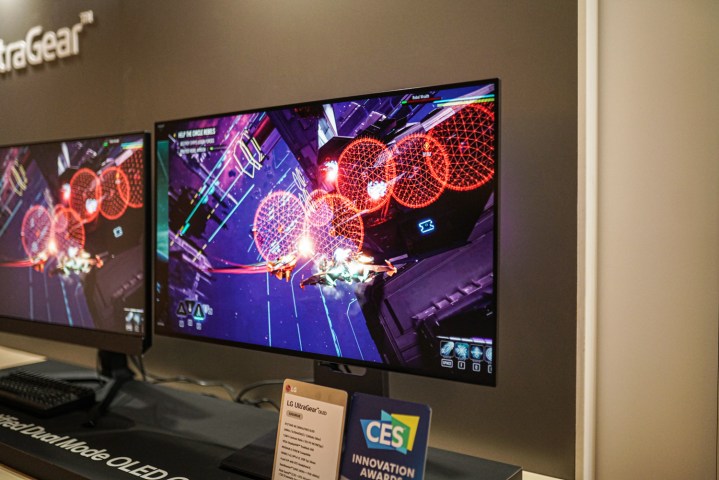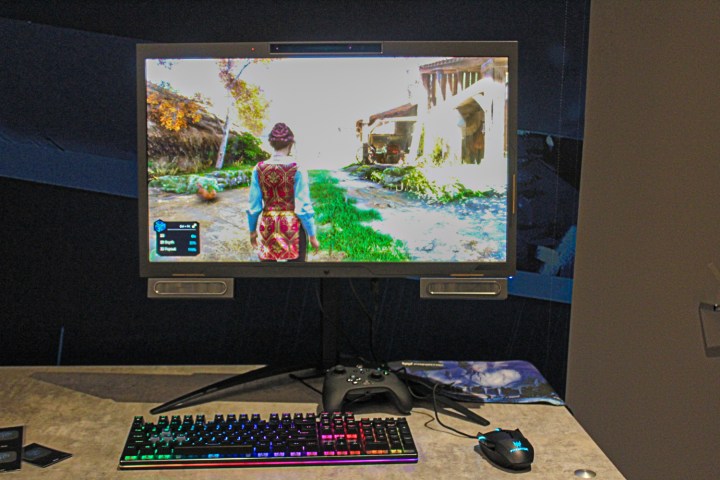
It was all about monitors at CES 2024, and we had a chance to see a lot of them. Samsung has exciting new gaming displays, Asus is pushing refresh rates to places they’ve never gone, and Acer is experimenting with some exciting glasses-free 3D tech. And that’s just the products I could fit in a three-item list.
Yes, we saw some exciting monitors at CES this year. Here are the best monitors we had a chance to lay our eyes on.
LG dual refresh rate OLED

It really didn’t take long for refresh rates to shoot up on OLED monitors. Just last year, we saw the first crop of 240Hz OLED displays, and we already have a 480Hz OLED from LG this year. It’s not 480Hz across the board, but LG is able to provide such a high refresh rate with its interesting dual refresh rate feature.
Basically, the monitor is a 32-inch, 4K OLED display with a 240Hz refresh rate in its base form. However, LG lets you toggle over to a 1080p resolution at 480Hz with a single button. It plays both the high-resolution, cinematic side of gaming and the super-fast competitive side, allowing you to have the best experience for the game you’re playing.
I suspect something like this has been possible for a while — lower resolution should mean you can achieve a higher refresh rate. LG is just making it a reality. Last year, we were singing the praises of the first 500Hz displays, regardless of how mediocre the image quality was. Now, you can get that same speed on an OLED panel, and that’s something to get excited about.
Samsung Odyssey OLED G8

Samsung is finally being boring, and I couldn’t be more excited. Instead of insane curves and crazy aspect ratios, the 2024 Odyssey OLED G8 is a flat, 32-inch gaming monitor with a 16:9 aspect ratio. It earns its stripes with a second-gen QD-OLED panel, however, and the introduction of 4K to the world of OLED gaming monitors.
On top of that, it sports a brand-new design that manages to look even better than last year’s model. It has the same slim silver frame, but the CoreSync bias lighting on the back is now brighter, and the stand is slightly smaller. The look elevates a gaming space, and that’s more than I can say for most other gaming monitors.
The specs are definitely here, too. You’re getting a 4K panel with a 240Hz refresh rate and, as usual, the stunning contrast of OLED. We’ll have to get this display under the microscope once it’s available, but it looks like an easy pick for the best gaming monitor of 2024 if it holds up. This is just the start, too. Other monitors are packing these same panels, including the new Alienware 27 QD-OLED and 32 QD-OLED.
Dell UltraSharp 120Hz displays

Gaming monitors have received all the love over the past few years, but Dell is changing that. Its new UltraSharp productivity displays are getting a big upgrade with a 120Hz refresh rate, finally bringing the smooth, premium feel of a gaming monitor to the desktop.
The UltraSharp 34 and UltraSharp 40 are curved 21:9 monitors, both of which use an IPS Black panel. The key feature here is the refresh rate, of course, but they come with a slew of other premium features, as well. Those include an integrated Thunderbolt hub and a built-in KVM switch.
The displays are pricey, with the 34-inch model coming in over $1,000, but it’s still nice to see some premium options in the world of productivity monitors. For too long, productivity displays have been stuck with the same bog-standard IPS panels and 60Hz refresh rates, and these two new Dell displays are changing that.
Asus 480Hz OLED monitor

This one definitely came out of left field. Asus has a 1440p OLED monitor with a native 480Hz refresh rate. No, that’s not a typo. 1440p. OLED. 480Hz. I would do the cliche of asking what more you could want, but the specs really speak for themself here.
I’m shocked. LG Display and Samsung Display make the lion’s share of panels for gaming monitors, so we normally know what to expect from brands like Asus at CES. Not this year. It seems Asus is the only one pushing this high of a refresh rate on an OLED monitor at 1440p, truly putting it in a class of its own.
Even more impressive is that Asus is claiming this display can hit a peak brightness of 1,300 nits, which would certainly make it the most impressive OLED we’ve ever seen. This is one we’ll need to test thoroughly once it’s available, but the specs alone are enough to get me excited.
Samsung 2D/3D gaming monitor

I’ve never been on the train of glasses-free 3D monitors. They just haven’t worked that well, but Samsung is changing that. The 2D/3D gaming monitor, as you might guess from the name, is more of a tech showcase than an actual monitor you can buy. But it’s a tease of what Samsung is cooking up, and we’ll hopefully hear more about it later this year.
As the name implies, this is a monitor that you can instantly switch from 2D to 3D, allowing you to have a solid gaming display when you need it or an immersive 3D monitor when you want it. It works with two cameras that track your eyes and head, providing a 3D view in any game you can throw at it. What surprised me most was that the tracking actually worked, getting around the dreaded sweet spot issue we’ve seen with previous glasses-free 3D displays.
In addition to standard games, the monitor supports VR games and content so that you can play them without a headset. We need to see more from this monitor, but for early impressions, it was definitely among the most impressive displays I saw at CES this year.
Predator SpatialLabs View 27

Speaking of glasses-free 3D, Acer has been chipping away at the tech for years with Spatial Labs. We saw this tech for the first time last year at CES, but only in laptops. Now, Acer is applying it to a 4K gaming monitor, fit with a 27-inch size and a resolution of 160Hz.
Acer’s implementation is better than Samsung’s, mainly because only a select list of games is supported through Spatial Labs. The list is fairly large at 113 titles and growing, and you can still use the monitor for standard 2D titles.
Acer may not have support for any game, or support for VR titles, but the experience is much better, and it’s a real monitor that you’ll be able to buy. Acer says the display will be available in the first half of this year for $2,000. Pricey, but that’s the cost of cutting-edge gaming tech.
Asus ZenScreen Fold OLED MQ17QH

What’s better than an OLED monitor? A portable OLED monitor that you can fold and put into a backpack, obviously. That’s what Asus is offering with its ZenScreen Fold OLED MQ17QH. It’s a 17.3-inch OLED display that folds into a 12.5-inch package, and with a weight of only 2.4 pounds, it’s easy to carry with you wherever you go.
Foldable screens still aren’t perfect, but this is the best application of foldable OLED we’ve seen so far. A kickstand is built into the display, allowing you to configure it for either a horizontal or vertical orientation. It’s quite a hefty stand, but if you’re looking for a more secure mount, Asus also includes a tripod mounting hole.
We don’t have a ton of details on the display yet, namely its price or availability. Asus tells me it will likely be on the more expensive end, but that’s expected for an OLED display you can throw in your bag.
HP Omen Transcend 32

HP has released plenty of gaming monitors under its Omen brand, but it’s certainly not the first company you think of when it comes to premium gaming displays. That’s changing with the HP Omen Transcend 32. It’s a QD-OLED monitor that measures 32 inches, and it’s capable of a 4K resolution at up to 240Hz.
We’ve seen a handful of similar monitors this year at CES, but this one is shocking because it comes from HP. It definitely wins some style points, too. The white shell looks wonderful, especially contrasted against a square of RGB lights around the back of the monitor.
Elsewhere, the monitor supports 140 watts of power delivery over USB-C, which is a first in this class of gaming monitor. This is HP’s first QD-OLED gaming monitor, so we’ll have to test it properly before making a judgment. It’s certainly a stunner from our early preview, though.




